Download this Backgrounder as a pdf
Despite Republican proposals for increased immigration, amnesty for illegal aliens, and new guestworker programs, there is no evidence of a Republican surge among Latino voters in the 2002 mid-term elections. The principal findings of election-day polls from 10 states with key races for U.S. Senate or governor are:
- The Latino vote for GOP Senate candidates was similar to prior years, at about one-third; gubernatorial candidates fared better, at close to one-half.
- But Latinos who voted in 2002 had higher income and education levels than the Latino electorate as a whole. Turnout of lower and middle income Latinos was much lower in 2002 than in 2000.
- Latino voters who identify themselves as "independents" are, in fact, likely to vote Democratic. The fact that many of these independents stayed home in 2002 helped Republicans.
- There is no "Latino" voting bloc, as such — after controlling for party identification, income, and education, there is no difference between Latino voting and the voting pattern of non-Hispanic whites in either the Senate or gubernatorial races of 2002. This is not true of African Americans, who are a distinctive voting bloc even after controlling for education, income, and party identification.
Following the 2002 mid-term elections, the strong Republican showing brought legions of GOP pundits, consultants, and sympathetic journalists forward to crow about the on-going realignment of Latino voters. Surely the big victories in Latino-heavy states like Texas (governor, U.S. Senate), Colorado (governor, U.S. Senate) and Florida (governor) were ample proof that the miscellaneous Latino outreach efforts undertaken by the GOP and its candidates had paid off.
At first the hype was easy to believe. It’s exciting to think that the traditional political science wisdom about the stability of partisan identity and political behavior is all wrong (Green, Palmquist and Schickler 2002) – that highly paid consultants really did earn their pay by exercising this magical power to manipulate mass political preferences; and that political consultants who sold candidates on their power to persuade were not just blowing smoke, but that legions of voters were actually waiting to be swayed by the next campaign advertisement or catchy slogan.
Then the facts began to roll in. In the most competitive U.S. Senate races, Republicans hardly gained any ground among Latinos, partly due to Democratic mobilization efforts. And modest improvements in the Latino GOP vote over the 2000 election came as the result of low turnout and demobilization, not political conversion. Since the facts speak so clearly, it made many wonder whether the enthusiastic claims about Latino conversion were merely spin, or whether the purveyors of this myth actually believe it to be true.
Consider the results from the 10 Fox News election-day polls from ten states with key U.S. Senate or gubernatorial races.1 The states included in the poll are: Texas, Florida, New Jersey, New Hampshire, Arkansas, Colorado, Georgia, Minnesota, Missouri, and South Dakota. These polls hardly represent the nation, but are likely to represent that segment of the 2002 electorate that confronted at least one competitive election (governor or U.S. Senate).
The results for Democratic and Republican voting in Figures 1 and 2 show that the share of the Latino vote that went to GOP candidates running for U.S. Senate was no more impressive than in previous years, running about one-third. On the other hand, the Hispanic vote for Republican Governors was an impressive 46 percent, ostensible evidence that Republicans have made in-roads. Of course we should keep in mind that a number of these gubernatorial races were not competitive, including Colorado where incumbent Bill Owens coasted to an easy reelection. But let’s consider the socioeconomic profile of the Latino voters who did show-up.
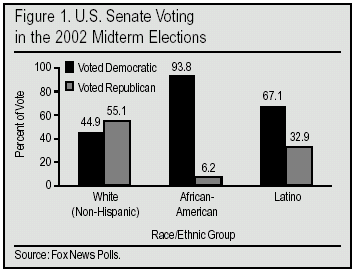
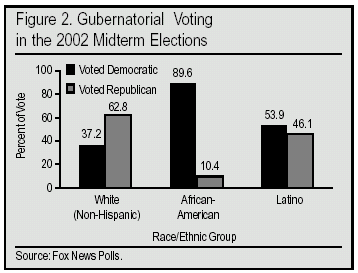
Income and Education
The cross tabulation of income by race/ethnicity reported in Table 1 clearly indicates that the Hispanics who voted in the 2002 contest had an unmistakably upper income and higher education profile. They were not average Latino voters; in fact, an unusually high proportion of the 2002 electorate could count themselves among the Latino elite. That the Republicans would do well among wealthy and well-educated Latinos who turned out in a mid-term election is not the least bit surprising. But it is hardly evidence that the Republicans are gaining ground. What it demonstrates is that Republicans do well when lower and middle income Latinos stay home, or only the most affluent vote.
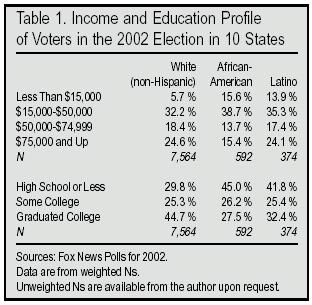
For instance, Table 1 shows that a whopping 24 percent of Latino voters showing up at the polls earned above $75,000 — about the same proportion as non-Hispanic white voters, and far wealthier than the African Americans who voted. Yet it doesn’t require intimate familiarity with the 2000 census to know that in the general (citizen) population Hispanic earnings lag well beyond the earnings of non-Hispanic whites. Latino voters in the 2002 election were far from representative of the broader Hispanic community of eligible voters.
The education profile is almost as distinctive (see Table 1). Among Latino voters in 2002, 32 percent had four-year college degrees (or more). This compares with 45 percent for whites, and 28 percent for African Americans. But we know that in the general population, Latinos of voting age lag far behind Anglo whites in the proportion who have finished college. The conclusion is clear: the 2002 Latino vote hardly represented the Latino citizen population, much less the Latino population in general (including permanent residents, illegal aliens, and other non-citizens).
Party Identification
Another way of examining the make-up of the Latino population in 2002 is to compare its distribution by party affiliation to similar data from the 2000 Voter News Service exit polls. Political scientists have commonly observed that mid-term elections differ from presidential elections mainly because of the weak presence of independents in the mid-terms. Only the most highly partisan voters are activated by the lower-stimulus mid-term elections, whereas independents and non-identifiers move into the electorate in presidential election years (Converse 1962). This is the phenomenon described as "surge-and-decline" in political science literature (Campbell 1966; Campbell 1987). If this generalization is also true of Latinos, we should see far more independents in the 2000 results than in the 2002 contest (see Figure 3).
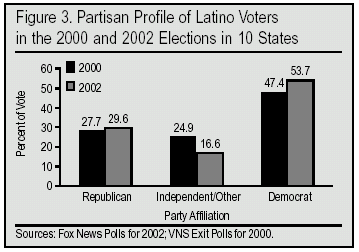
Not surprisingly, this is exactly what we see in Figure 3. In 2000, self-identified Latino independents comprised 25 percent of the Latino electorate, compared with just 16.6 percent in 2002 – an eight percentage-point difference. This closely mirrors the non-Hispanic white drop-off from the presidential to the off-year, which also ran about eight points.
The difference in 2002, then, is one of turnout, but the story is more nuanced than simply saying that fewer Latino Democrats showed up at mid-term. Actually, a slightly higher proportion of them were present in 2002 than in 2000 (see Figure 3). The voters who were present in 2000, but not in 2002 were lower- and middle-income independent-identifying Latinos, with middling education levels, who "float" in and out of the electorate. These independent floaters behave more like the Democrats around whom they live and work, so their absence in the 2002 contests meant the Republicans would be in a better position to win a larger share of the Latino vote, which they did in some of the gubernatorial races.
That the drop in the share of self-identified independents might help Republicans in the mid-term is, of course, extremely discouraging news for the GOP. After all, it is independent voters who are typically targeted for persuasion-oriented advertising and outreach. But the high turnout of Latino independents helps Democrats because more of these Latinos lean toward that party in the first place, and certainly their friends and neighbors who influence them do.
Patterns of Support
As if the income and education profiles were not evidence enough of the upper-class bias of Latino voting in 2002, consider the fact that fully 49 percent of those Latinos who showed up at the polls in these 10 states had voted for George W. Bush in the 2000 presidential election. That these same voters would return in the off-year election to cast a similar share of their votes for Republican gubernatorial candidates is to be expected, and hardly provides evidence of widespread political conversion.
If Republican candidates have converted any Latino voters, we should see the Latinos who cast ballots for Gore in 2000 coming to the Republican side in 2002. Did any of Gore’s Latino supporters convert? The data show that precious few Gore voters in the Latino community supported Republican Senate candidates in 2002. Table 2 shows that Latinos who had voted for Gore were scarcely more likely to vote for a GOP U.S. Senate candidate (3.7 percent) than African Americans (3 percent).
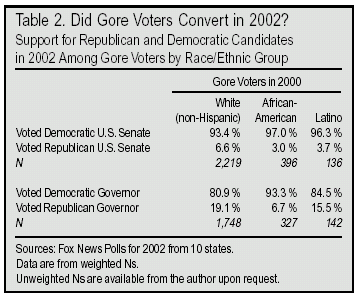
To be sure, Latinos who had supported Gore were more favorable toward the GOP gubernatorial candidates, but this should come as no great surprise given the non-competitive nature of the gubernatorial contests in several of the states where the polls were conducted. If these elections would have been more competitive, and Latino turnout higher, many of these easy GOP victories would have been narrower. The moral of the data is clear: Republican candidates do well among Latino voters if Latino turnout remains low. But gaining ground through the low turnout of Democrats, and gaining ground by Latino political conversion, are two entirely different goals. Republicans will continue to struggle in attaining the latter.
Texas and Florida
What about the Florida and Texas governorships? Didn’t Hispanic Democrats surge into Republican ranks in these two states? Not according to the FOX News polls. In Texas, almost no Latinos who had supported Gore in 2000 cast votes for GOP Senate candidate John Cronyn. And in the governors’ races, about 8 percent of Latinos who had supported Al Gore cast votes for Rick Perry and Jeb Bush — a respectable improvement, but no evidence of a surge. In Florida, Jeb Bush polled much worse among Latinos in 2002 (57percent) than he had in his narrow loss to Lawton Chiles in 1994 (71 percent). If I learned first grade mathematics correctly, these figures are headed in the wrong direction — surprising given that 2002 found the President’s brother a well-entrenched incumbent whereas 1994 found him a relative neophyte. Moreover, the Latino Democrats who voted for Perry and Bush look very much like Republicans, and most of them voted Republican in the 2000 election — so there is meager evidence of Latino political movement between 2000 and 2002. The consultants who consider themselves so adept at manipulating voters’ allegiances are living in a dream world. The evidence strongly supports the conventional view of political science — that partisan commitments and policy preferences are highly stable, and campaign messages matter much less than political consultants would have gullible politicians believe (Green, Palmquist, and Schickler 2002).
The Poor and Dropouts
We can amplify our points about the Latino vote by comparing the behavior of this group to other social groups in the mid-term. By examining the percentage of Latinos who cast GOP ballots in comparison to those who cast ballots in low income and low education groups, we can evaluate the extent to which Hispanic voters are a distinctive bloc in the gubernatorial and U.S. Senate races (see Table 3).
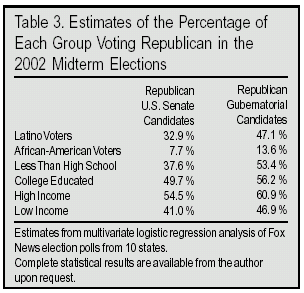
What the figures derived from statistical analysis reveal is that even though an estimated 47 percent of Latinos supported the GOP’s gubernatorial candidates in 2002, a similar percentage of lower income voters (earning less than $20,000) did also, as did a majority of those with less than a high school education. One wonders if this makes the case for aggressive Republican outreach to high school dropouts and low income voters. Most GOP strategists would hardly take this suggestion seriously, but it makes about as much sense as focused Latino outreach does.
Indistinct Bloc
The results reported in Table 4 indicate that after controlling for party identification, income and education, there is no difference between Latino voting and the voting pattern of non-Hispanic whites in either the Senate or gubernatorial races of 2002. This raises serious questions about whether Latinos are a distinctive voting bloc at all. While black distinctiveness persists even after controlling for education, income, and party identification, Latino distinctiveness clearly does not. After we account for their education and income levels, the "Latino vote" disappears as such. This too is a conventional finding among social scientists who have discussed the lack of a "pan-ethnic" identity across the various Latino nationality groups (DeSipio 1996; Jones-Correa and Leal 1996; Kaufmann 2002; Lopez and Espiritu 1990).
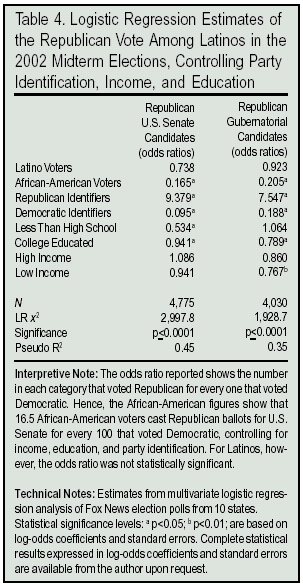
This collection of results raises a very important question. Why do parties and candidates want to treat Latinos as if they were like African Americans, a distinctive voting bloc?
If Latinos cannot be politically distinguished on the basis of ethnicity after we account for their income and education levels, why do we persist in the belief that we need to reach them with a distinctive set of policy proposals on immigration, illegal-alien amnesties, guestworker programs, or any other set of issues tailored only around "their" interests? The findings presented here strongly suggest that there is no "them" at least in mid-term contests. Given their heterogeneity, the idea that "they" can be moved by ethnically-specific issue appeals has little merit. General themes designed to promote upward mobility and educational opportunity are likely to work as well as they do with any subset of voters in an economically disadvantaged position. But poverty and access to education are not uniquely "Latino" problems. The characteristics that do distinguish Latinos as an ethnic group: sharing a common language, their predominant Catholicism, and an Iberian influenced heritage, have no obvious and consistent political ramifications.
I am left with much the same conclusion that I have expressed in previous research on this subject (Gimpel and Kaufmann 2001). Playing ethnic politics with a group this diverse will continue to be a waste of time, and is as likely to insult and turn off Latinos (to say nothing of non-Latino voters) as it is to turn them on to Republican party politics. And the process of turning a predominantly Democratic group into a Republican one will take a lot of time because younger Latinos continue to learn from their elders that their economic interests are generally better served by the Democrats. And once individual Latinos have acquired a firm partisan identity, they are no more persuadable than any other American citizen.
Looking to 2004
Finally, a fascinating question placed on the FOX News polls asked whether voters would reelect George W. Bush in 2004. The data tell a cautionary tale while suggesting the behavioral similarity of Latinos to non-Latinos. Support for the President’s reelection dropped precipitously among Latinos’ with grim perceptions of national economic conditions. Although the President remains popular among a solid majority of American voters, including those of Hispanic ancestry, this support is far from anchored in a firm commitment to re-elect him. Aside from being more cognizant of turnout, taking measures to ensure a strong economy will be the best path to sustained popularity and a successful reelection bid.
Since the persuasive power of campaigns is greatly exaggerated, Republicans would be better off in the short-term focusing their efforts on targeting and mobilizing Latino voters who have voted their way in the past. This is not so much a matter of adopting specific policy stands as it is an effort to contact and mobilize people with the appropriate voting history. This involves turning to voting lists and studying the geography of Republican-inclined Latinos. Simply put, the turnout efforts in areas of Latino Republican concentration must be superior to the determined mobilization efforts of Democrats in the Latino Democratic areas. If the 2002 mid-term election reminds us of anything, it should remind us that turnout decides elections far more than persuasive appeals directed toward voters who are paying scant attention. We can all be relieved that fundamental political commitments are not nearly so volatile and subject to manipulation as political consultants want their candidates to believe. But the emperor is wearing at least one shred of clothing – a t-shirt with the word "turnout" written across it.
End Note
In previous years, the source of election day polling data by state was the Voter News Service, a research organization created as a collaborative effort of the four major networks, CNN and the Associated Press, and based in New York. On Election Day (November 5, 2002) VNS announced that it was “not satisfied with the accuracy of today’s exit poll analysis and will not be in a position on election night to publish the results of state and national surveys of voter attitudes.” Although the VNS computer system was redesigned after the 2000 election in which networks used VNS data to incorrectly call states, including Florida, VNS officials were not sufficiently confident in the accuracy of the information produced by the new computer system to release the data for media use. Actually, the VNS 2000 polls were not deeply flawed, exit polls simply have limitations of which most non-experts are unaware. Exit polls can never definitively predict the results of elections in the very tightest races due to the typical margins of error (3 and 5 percent). The 2000 election debacle was much more of a problem with news anchors being too hasty to call races, not a problem with the polls per se. Much of the 2002 data VNS collected may eventually be available for scholarly research, and VNS did generate election night information for purposes of declaring winners and losers.
Sources
Campbell, Angus. 1966. "Surge and Decline: A Study of Electoral Change.’ In Elections and the Political Order, eds. Angus Campbell, Philip E. Converse, Warren E. Miller and Donald E. Stokes. New York: John Wiley and Sons.
Campbell, James E. 1987. "A Revised Theory of Surge and Decline." American Journal of Political Science 31: 965-979.
Converse, Philip E. 1962. "Information Flow and the Stability of Partisan Attitudes." Public Opinion Quarterly. 26: 4: 578-599.
DeSipio, Louis. 1996. Counting on the Latino Vote. Charlottesville, VA: University of Virginia Press.
Garcia, F. Chris, ed. 1988. Latinos and the Political System. Notre Dame, IN: University of Notre Dame Press.
Gimpel, James G. and Karen M. Kaufmann. 2001. "Impossible Dream or Distant Reality? Republican Efforts to Woo Latino Voters." Center for
Immigration Studies Backgrounder. Washington, DC: Center for Immigration Studies.
Green, Donald Philip, Bradley Palmquist and Eric Schickler. 2002. Partisan Hearts and Minds: Political Parties and the Social Identities of Voters. New Haven, CT: Yale University Press.
Jones-Correa, Michael and David L. Leal. 1996. "Becoming ‘Hispanic’: Secondary Panethnic Identification among Latin American-Origin Populations in the United States." Hispanic Journal of Behavioral Sciences 18: 214-254.
Kaufmann, Karen. n.d. "Cracks in the Rainbow: Group Commonality as a Basis for Latino and African-American Political Coalitions." Forthcoming in Political Research Quarterly.
Lopez, David and Yen Espiritu. 1990. "Panethnicity in the United States: A Theoretical Framework." Ethnic and Racial Studies 13: 2: 198-224.
James G. Gimpel is Professor of Government at the University of Maryland, College Park. He can be reached at [email protected]. Dr. Gimpel wishes to thank Professor Daron R. Shaw of the University of Texas, Austin, for graciously sharing the Fox polling data.
